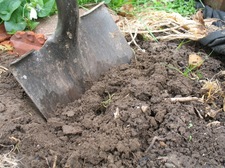How to get a garden plot tilled?
 Laura emails with a timely question:
Laura emails with a timely question:
Can anyone recommend a reliable, reasonable service for rototilling a vegetable garden plot?
If you know of a service, great. But even if you don't, maybe you have some alternate ideas that could help Laura get her garden plot in shape.
Got a suggestion? Please share!
Hi there. Comments have been closed for this item. Still have something to say? Contact us.
Comments
When we started our backyard garden a few years ago, we split the cost of a rototiller day rental from Home Depot with a neighbor. I don't remember it being expensive. And it was relatively easy to use after a few minutes.
But. It was kind of a pain to get in and out of the back of the car. Another reason to find a friend to split the rental.
... said Greg on May 9, 2013 at 11:51 AM | link
If it's a big plot or hasn't been worked before, you'll probably want to rototill the first year and I'll let other commenters make suggestions there. But there is a school of thought that says rototilling disrupts the micro ecosystem of the soil and more gentle methods of turning over the soil (turning fork, shovel) is better. I've always done my 450 sq ft plot by hand. It's a fair amount of exercise so I do it in chunks over a week or two.
There are some other hints for keeping your soil loose from year to year. Minimize walking directly on your beds so you don't compact the soil, especially clay. Arrange the width of your beds so you can plant, weed, harvest by bending over the bed and not stepping into the bed. Also, every year add more organic matter to add structure to the soil. This will make it less compact and easier to turn over in the spring.
... said chrisck on May 9, 2013 at 12:00 PM | link
Most equipment rental companies rent tools like roto-tillers for about $35 per day. Maybe you and a friend with a truck or van could split the cost?
... said addiesdad on May 9, 2013 at 12:00 PM | link
It all depends... If it's an area with lawn, you should remove the layer of grass first, down to the bare soil. The flat side of a pick works well for this, with minimum effort. After that is done, you can use a rototiller if the area is large, or a regular shovel if the area is small. Rear-tillers are easier to handle than front tillers. You must run the tiller several times back and forth, until the soil is completely loose to about a deopth of 12 inches. If done with a shovel, start at one end, sink the shovel as deep as you can and flip the soil over. Repeat this several times. Once this process is completed, you should improve the soil by adding peat moss (4 cuft for about a 10X10 space), sphagnum (a couple of bags) and pelletized lime (about 20 lbs for a 10X10). Most soils in this area are acid, so the lime conditions the soil and also helps reduce the acidity of peat moss and sphagnum. Set the grass that you removed to the side and let it break down. You can work it into the soil of your garden in the Fall. For neat looks and better results, you can surround your new garden with 2X6 lumber, partially buried. Do not use pressure treated lumber. Though it lasts longer, the chemicals in it may be harmful. use regular dimensional pine lumber. It will only last three or four years, but it's cheap enough to replace. Work the sphagnum, peat moss and lime into the soil with your shovel or rake. Water the new area thoroughly and let it sit for a few days before planting. When planting, add a general fertilizer to the soil, such as a 10.10.5. These fertilizers are safe and are very helpful to boost plant growth. have a good harvest!
... said Joe on May 9, 2013 at 2:31 PM | link
I agree with much of what Joe says, but would rethink the idea of using peat moss. I only learned this year that peat moss is not really a renewable resource in that the peat moss bogs that are the source of much commercial peat (mostly in Canada) take thousands of years to develop. I got this info from a master gardener at Cooperative Extension.
I'm a fan of compost and composted manure. You can buy it in bags until you can produce enough of your own home-made compost from kitchen waste and yard waste. Also, depending on where you live, you can get free municipal compost.
In the fall consider growing an inexpensive cover crop ( "green manure") like winter rye or a clover and in the spring you will turn that over to decompose in your soil. Agway sells cover crop seeds. Just throw down the seed in the fall and forget about it.
... said chrisck on May 9, 2013 at 4:41 PM | link